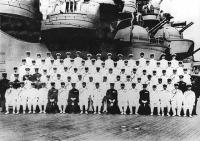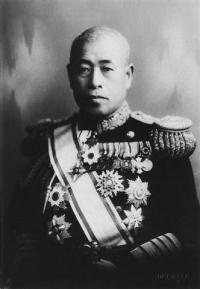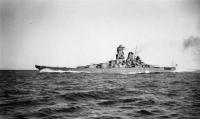
Japanese Emperor Hiro-Hito (ctr.) on the Musashi.

Japanese Admiral Isoroku Yamamoto

Japanese Vice Admiral Takeo Kurita

Pride of the Japanese Navy, super battleship Yamoto.
In the mid 1930’s, Japanese Naval Engineers were tasked with designing the world’s biggest battleship. Built in secret, the Japanese hoped to surprise the Americans with a boat that was invincible against existing ships. The battleships were outfitted with nine 18.1” naval guns – the largest ever fitted on a naval vessel. As a comparison, the largest gun on any American ship was 16", while the Bismarck’s were 15". Named for the poetic name for Japan, these ships were going to be the pride of the Japanese Navy. Although five Yamato class ships were planned, only two were built and a third was converted during construction to an aircraft carrier.
The largest ships ever constructed at the time, the two Yamato class vessels displaced 64,000 tons each and had armor up to two feet thick. The 18.1” guns were capable of firing a shell weighing nearly 3,200 lbs. over a distance of 26 miles every two minutes. A single three-gun turret weighed more than a 1930’s era destroyer.
Eight days after the attack on Pearl Harbor, the Japanese commissioned the first super battleship Yamato. The Musashi, the second Yamato class battleship, was commissioned nine months later.
Yamato completed its training exercises in May 1942 when Admiral Isoroku Yamamoto deemed the vessel “operable.” During the Battle of Midway in June, Yamato served as the flagship of the Japanese Combined Fleet. Even though the Japanese Navy lost four aircraft carriers to attacks by American planes, the ship never engaged enemy forces.
Over the next two years, Yamato went between the naval bases at Truk & Kure, switching off with its sister ship Musashi as flagship of the Combined Fleet. Also during this time period, it was deployed on multiple occasions as part of the First Battleship Division to counteract American attacks on Japanese bases in the Pacific.
In November 1943, Yamato and Musashi were used as transport vessels because of their armor protection and large storage capacity. In December, while transporting troops and equipment to the Admiralty Islands, Yamato was severely damaged by two torpedoes from the American submarine USS Skate. The ship retreated to the naval base at Truk for emergency repairs.
After undergoing repairs & a retrofitting at the Japanese naval base at Kure, Yamato was sent on a transport mission in April 1944. In early June, being used again as a troop transport, the ship had to abort its mission, when news arrived of an American carrier force attacking the Mariana Islands.
With new orders, Yamato took part in the Battle of the Philippine Sea, also known as “The Great Marianas’ Turkey Shoot.” More than 400 Japanese aircraft were lost and three aircraft carriers sunk. Yamato’s part in the engagement came when it mistakenly opened fire on its own aircraft.
On October 22-25, 1944, the Yamato and its sister ship Musashi took part in the largest naval battle in history – the Battle of Leyte Gulf. After American submarines sank the ship Atago, Japanese Admiral Takeo Kurita transferred his flag to Yamato. Soon after, the new flagship would be in the middle of the fight.
In the Sibuyan Sea, aircraft from the USS Essex put three armor-piercing bombs into Yamato. Musashi, the other super battleship, was hit with 17 bombs and 19 torpedoes sending it to the bottom of the ocean. While shooting down 18 American planes, the ship lost just more than 1,000 of its 2,399 sailors (the remainder were rescued by Japanese destroyers).
The Yamato navigated the San Bernadino Strait to attack a small force of American destroyers and escort carriers. In its only naval engagement, the ship scored hits on a destroyer, a destroyer escort, and an escort carrier. Yamato spotted a spread of torpedoes heading its way, forcing it to disengage and retreat.
On its way to Kure Naval Base for upgrades and repairs, Yamato’s battle group was attacked in the East China Sea by the submarine USS Sealion. A smaller battleship and several destroyers were sunk in the attack.
Sitting in dock at the Kure Naval Base, the ship was attacked on March 19, 1945, by aircraft from three American aircraft carriers. Defended by an elite group of veteran Japanese pilots and multiple antiaircraft guns, Yamato received little damage. Soon after, the ship took a full stock of ammunition in preparation for its next mission –Operation Ten-Go.
Operation Ten-Go was a suicide mission by Yamato and nine escorts that began on April 6, 1945. The Yamato planned to go straight for Okinawa, beach itself to make it unsinkable, and empty its 18.1” guns on American forces. Filled with only enough fuel to make it to its destination, the ships departed Kure for Okinawa.
Going through the Bungo Strait, two submarines spotted the Japanese ships and notified the American fleet. Just after noon on April 7, 1945, 280 American planes attacked Yamato hitting it with two bombs and one torpedo and sinking two of its escorts. After a second strike by 100 American planes that led to a total of 10 torpedo and seven bomb hits, Yamato’s forward ammunition magazine exploded. The smoke from the detonation rose more than 4 miles high & was seen 100 miles away on the Japanese home island of Kyushu. Fleet commander Vice Admiral Seiichi Ito and 2,497 sailors were lost leaving only 200 survivors.
With the sinking of Yamato – the pride of the Imperial Japanese Navy - the age of the super battleship was over. The great navies would invest their resources on aircraft carriers leaving the battleship to a bygone era.
«Go back to the previous page.



